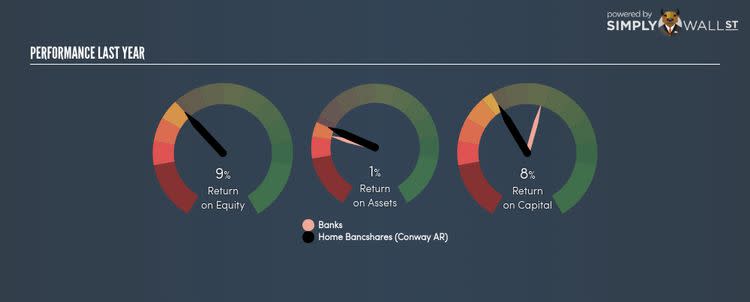With An ROE Of 9.16%, Has Home Bancshares Inc (Conway AR)’s (HOMB) Management Done A Good Job?

Home Bancshares Inc (Conway AR) (NASDAQ:HOMB) delivered an ROE of 9.16% over the past 12 months, which is an impressive feat relative to its industry average of 8.95% during the same period. Superficially, this looks great since we know that HOMB has generated big profits with little equity capital; however, ROE doesn’t tell us how much HOMB has borrowed in debt. In this article, we’ll closely examine some factors like financial leverage to evaluate the sustainability of HOMB’s ROE. See our latest analysis for HOMB
What you must know about ROE
Return on Equity (ROE) weighs HOMB’s profit against the level of its shareholders’ equity. For example, if HOMB invests $1 in the form of equity, it will generate $0.09 in earnings from this. While a higher ROE is preferred in most cases, there are several other factors we should consider before drawing any conclusions.
Return on Equity = Net Profit ÷ Shareholders Equity
ROE is measured against cost of equity in order to determine the efficiency of HOMB’s equity capital deployed. Its cost of equity is 11.27%. This means HOMB’s returns actually do not cover its own cost of equity, with a discrepancy of -2.11%. This isn’t sustainable as it implies, very simply, that the company pays more for its capital than what it generates in return. ROE can be broken down into three different ratios: net profit margin, asset turnover, and financial leverage. This is called the Dupont Formula:
Dupont Formula
ROE = profit margin × asset turnover × financial leverage
ROE = (annual net profit ÷ sales) × (sales ÷ assets) × (assets ÷ shareholders’ equity)
ROE = annual net profit ÷ shareholders’ equity
Basically, profit margin measures how much of revenue trickles down into earnings which illustrates how efficient HOMB is with its cost management. Asset turnover shows how much revenue HOMB can generate with its current asset base. The most interesting ratio, and reflective of sustainability of its ROE, is financial leverage. Since ROE can be artificially increased through excessive borrowing, we should check HOMB’s historic debt-to-equity ratio. At 70.77%, HOMB’s debt-to-equity ratio appears sensible and indicates the above-average ROE is generated from its capacity to increase profit without a large debt burden.
What this means for you:
Are you a shareholder? HOMB exhibits a strong ROE against its peers, however it was not high enough to cover its own cost of equity this year. Since its high ROE is not fuelled by unsustainable debt, investors shouldn’t give up as HOMB still has capacity to improve shareholder returns by borrowing to invest in new projects in the future. If you’re looking for new ideas for high-returning stocks, you should take a look at our free platform to see the list of stocks with Return on Equity over 20%.
Are you a potential investor? If HOMB has been on your watch list for a while, making an investment decision based on ROE alone is unwise. I recommend you do additional fundamental analysis by looking through our most recent infographic report on Home Bancshares (Conway AR) to help you make a more informed investment decision.
To help readers see pass the short term volatility of the financial market, we aim to bring you a long-term focused research analysis purely driven by fundamental data. Note that our analysis does not factor in the latest price sensitive company announcements.
The author is an independent contributor and at the time of publication had no position in the stocks mentioned.


